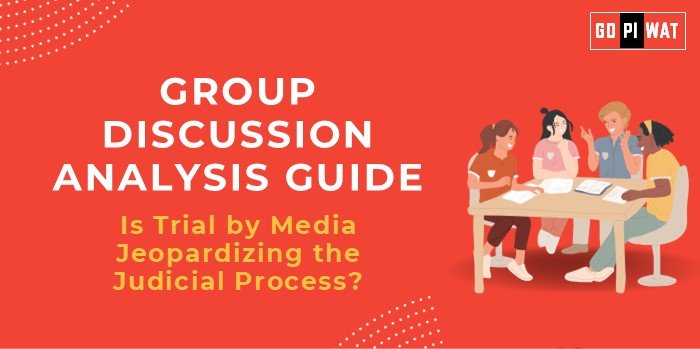📋 Group Discussion (GD) Analysis Guide
Topic: Is Trial by Media Jeopardizing the Judicial Process?
🌐 Introduction to the Topic
Context Setting: The role of media as the “fourth pillar” of democracy is indispensable for ensuring transparency, accountability, and public awareness. However, the growing trend of media conducting “parallel trials” has sparked concerns about its influence on judicial proceedings. The debate centers on whether this dynamic fosters transparency or compromises the sanctity of justice.
Topic Background: The phenomenon of “trial by media” gained attention in high-profile cases like the Jessica Lal murder trial, the Aarushi Talwar case, and the Sushant Singh Rajput investigation. In these instances, sensationalized media coverage led to public judgments, sometimes preceding court verdicts. Internationally, the O.J. Simpson case also highlights the global relevance of this issue.
📊 Quick Facts and Key Statistics
- 📉 Prejudicial Reporting Impact: In a survey by the Indian Express (2022), 60% of respondents agreed that excessive media coverage influences public perception of guilt.
- 🌍 Global Cases: In the U.S., high-profile trials like O.J. Simpson’s were criticized for media interference in the judiciary.
- 📰 Public Perception in India: Cases like the Sushant Singh Rajput trial showcased media’s role in shaping narratives before evidence was presented in court.
- ⚖️ Judicial Standpoint: The Supreme Court of India has criticized “media trials,” stating they can influence witness testimonies and judicial fairness (Justice K.G. Balakrishnan, 2010).
👥 Stakeholders and Their Roles
- 📰 Media Houses: Delivering news responsibly while avoiding prejudicial narratives.
- ⚖️ Judiciary: Safeguarding the principle of “innocent until proven guilty.”
- 🗣️ General Public: Consuming media content and forming opinions based on reportage.
- 📜 Regulatory Bodies: Ensuring media operates within ethical guidelines to protect judicial integrity.
🏆 Achievements and Challenges
✨ Achievements
- 📢 Increased Awareness: Media has highlighted cases requiring urgent attention, such as the Nirbhaya case.
- ⚖️ Accountability: Exposure of high-profile misconduct has spurred judicial and governmental action.
⚠️ Challenges
- 📉 Prejudicial Influence: Sensationalized coverage often leads to public prejudgment, undermining judicial impartiality.
- ⚖️ Pressure on Judiciary: Media narratives can create undue pressure on judges, affecting verdicts.
- ❌ Witness Manipulation: Extensive media scrutiny can deter witnesses from testifying truthfully.
Global Comparisons:
• United States: The O.J. Simpson trial showcased media’s potential to polarize public opinion, though it remained within free speech bounds.
• United Kingdom: Strict contempt of court laws curb prejudicial reporting.
Case Studies: The Aarushi Talwar murder trial in India saw intense media scrutiny, which influenced public opinion but failed to clarify the judicial process.
📢 Structured Arguments for Discussion
- 💬 Supporting Stance: “Media trials create public awareness and demand accountability in cases like Nirbhaya.”
- 🗣️ Opposing Stance: “By shaping narratives, media trials often compromise the principle of fair trial.”
- ⚖️ Balanced Perspective: “While media enhances transparency, responsible journalism is essential to safeguard judicial integrity.”
📈 Effective Discussion Approaches
- 💡 Opening Approaches:
- Use a compelling statistic: “In 2022, 70% of surveyed Indians believed media coverage affects trial outcomes.”
- Cite examples: “The Aarushi Talwar case exemplifies the dual-edged nature of media trials.”
- 💡 Counter-Argument Handling:
- Acknowledge merits of media scrutiny but emphasize regulated guidelines to mitigate risks.
📊 Strategic Analysis of Strengths and Weaknesses
Strengths
- 📢 Drives public discourse and judicial accountability.
- 📰 Brings underreported cases to the forefront.
Weaknesses
- 📉 Risks prejudicing juries and judges.
- ❌ Encourages sensationalism over substance.
Opportunities
- 📜 Develop frameworks for ethical journalism.
- ⚖️ Enhance collaboration between media and judiciary for balanced reporting.
Threats
- ⚠️ Erosion of public trust in judiciary.
- 📉 Manipulation of narratives for political or economic gain.
🎓 Connecting with B-School Applications
- 💡 Real-World Applications:
- Understanding ethics in media management and public relations.
- Exploring regulatory frameworks for journalism in corporate litigation.
- 💡 Sample Interview Questions:
- “How should businesses handle media coverage during legal disputes?”
- “Discuss the ethical balance between free press and fair trials.”
- 💡 Insights for B-School Students: Recognize the power of narratives in influencing public and judicial outcomes. Develop skills to manage media crises effectively.


